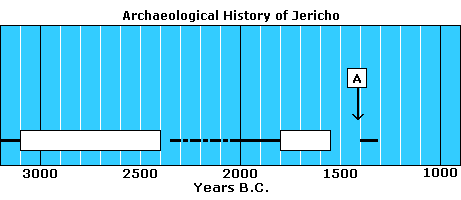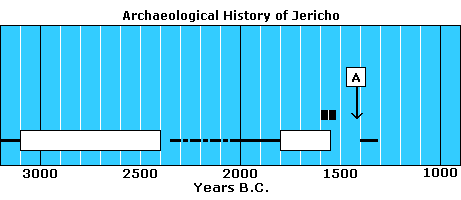
|
|
|
|
|
|
Home
About
Resources
anti-aging vitamins books
- A New Approach...
- The Exodus Happened 2450 B.C.
- Noah's Flood Happened 3520 B.C.
- Age of the Earth Collection
- Aging: Cause and Cure
- Bread from Heaven: The Manna Mystery Solved
newsletters
podcast
speaker for an event
time charts
videos
Topics
Overview
Biblical Chronology Dendrochronology Radiocarbon Dating Mt. Sinai Jericho Ai The Exodus Noah's Ark Imhotep/Joseph
Correspondence
- anti-aging vitamins
- antiquity of mankind
- ark search
- Bible chronology
- "The BC" publication
- Bryant Wood's critique
- calendars
- Heshbon
- horses and chariots in Egypt
- Jericho --- Joshua's curse
- lifespan research
- missing millennium: reception
- missing millennium: textual
- Mt. Sinai
- Noah's Flood
- Philistines
- radiocarbon
- Sodom and Gomorrah
- teaching science and creation
- the Exodus
- tree rings
- virtual history
- young earth creation
Contact Us
Is Bryant Wood's chronology of Jericho valid?The following article is abstracted from The Biblical Chronologist Volume 2, Number 3. Full details and references can be found there.The Problem to be SolvedIn Joshua chapter 6, the Bible records the defeat of the city of Jericho by the children of Israel, led by Joshua. Traditional biblical chronology places this event ca. 1407 B.C. The archaeological remains at Tell-es-Sultan correspond to the biblical Jericho. This is undisputed by mainstream scholarship, whether conservative or liberal. John Garstang conducted excavations at Jericho from 1930 to 1936. He found a destruction layer corresponding to the termination of City IV, and dated it to ca. 1400 B.C. This worked out well for traditional biblical chronology. However, in the 1950's, Kathleen Kenyon conducted further excavations at Jericho and concluded that the destruction of Garstang's City IV should be dated ca. 1550 B.C., not ca. 1400 B.C. In fact, Kenyon found no evidence at all of occupation of Jericho ca. 1407 B.C. The following figure shows the chronology of Jericho held by nearly all modern archaeologists. The dashed line represents a period when Jericho was merely a campsite, the solid lines indicate an unwalled town, and the rectangles indicate a walled city. The letter 'A' points to 1407 B.C., the traditional biblical date for the destruction of Jericho by Joshua.  Clearly traditional biblical chronology is in conflict with the chronology of Jericho held by the consensus of modern archaeologists. The termination of the walled city (City IV) ca. 1550 B.C. is the chronologically closest candidate to the traditional biblical date for the destruction of Jericho by Joshua, but it is still about 150 years from the traditional biblical dates according to the scholarly consensus. Clearly the destruction of City IV Jericho and the destruction of Jericho by Joshua cannot be the same event if they are separated by 150 years. Wood's Proposed SolutionIn the March/April 1990 issue of Biblical Archaeology Review conservative biblical archaeologist Dr. Bryant G. Wood proposed that Garstang was right all along. He proposed that the termination of City IV Jericho be redated from ca. 1550 B.C. to ca. 1400 B.C. He argued that a reanalyis of pottery shards excavated from City IV, stratigraphic considerations, scarab evidence, and a single radiocarbon date all converged "to demonstrate that City IV was destroyed in about 1400 B.C.E., not 1550 B.C.E. as Kenyon maintained." Wood's proposal received press coverage and positive reaction from conservative sectors, but his fellow archaeologists did not react so favorably. In a subsequent issue of Biblical Archaeology Review, Piotr Bienkowski attacked Wood's arguments and then summarized his assessment of Wood's claims as follows: Wood has attempted to redate the destruction of Jericho City IV from the end of the Middle Bronze Age (c. 1550 B.C.) to the end of the Late Bronze I (c. 1400 B.C.). He has put forward four lines of argument to support his conclusion. Not a single one of these arguments can stand up to scrutiny. On the contrary, there is strong evidence to confirm Kathleen Kenyon's dating of City IV to the Middle Bronze Age. Wood's attempt to equate the destruction of City IV with the Israelite conquest of Jericho must therefore be rejected.Wood responded to Bienkowski in the same issue with a more detailed discussion of pottery shards. He charged: Bienkowski's attempt to explain away the evidence for lowering the date of the destruction of Jericho is misguided and void of substance. Assertions made without data to back them up are unconvincing. His discussion is superficial, at best, lacking both depth and precision.And so the battle raged. Settling the DisputeIt is clear that the question is one of chronology. When was City IV Jericho destroyed? The scholarly consensus says ca. 1550 B.C., Wood says ca. 1400 B.C. What source can we turn to to settle this dispute? In fact, radiocarbon is such a source. In the early 1990's, when Wood first published his claims, there was only one radiocarbon measurement available for City IV. It was from a piece of charcoal dated by the British Museum to 1410 plus or minus 40 years B.C. Unfortunately, this date was later retracted by the British Museum, along with dates of several hundred other samples. The British Museum found that their radiocarbon measurement apparatus had gone out of calibration for a period of time, and thus had yielded incorrect dates during that period. The corrected date for the charcoal sample from City IV turned out to be consistent with Kenyon's ca. 1550 B.C. date for the City IV destruction. The corrected date no longer supported Wood's proposal, but it was insufficient to falsify the proposal. Radiocarbon dates on charcoal give the date the wood grew, not the date it was burned. To be consistent with Bryant Wood's proposal, the wood which burned to produce the charcoal sample would need to have been cut from a living tree 150 years prior to the destruction. Of course, this is not impossible. As mentioned earlier, no other radiocarbon dates from samples from City IV Jericho were available in the early 1990's. In 1995, however, results were published by Hendrik J. Bruins and Johannes van der Plicht from high-precision radiocarbon measurements made on eighteen samples from Jericho. Six of these samples were charred cereal grains from the City IV destruction. Bruins and van der Plicht did not set out to disprove Wood's thesis. Their stated purpose was to contribute "toward the establishment of an independent radiocarbon chronology of Near Eastern archaeology." The chart below is the same as the chart shown earlier. Heavy black bars have been added showing the range of dates radiocarbon gave from the six charred grain samples from City IV Jericho.  Bruins and van der Plicht recognized the results of their work held a serious implication for Wood's theory. They devoted only one sentence to this implication: Further, the fortified Bronze Age city at Tell es-Sultan [Jericho] was not destroyed by ca.1400 BC, as Wood (1990) suggested.As is evident from the chart, the radiocarbon measurements strongly support the chronology advanced by Kenyon long before the radiocarbon measurements were made. This radiocarbon evidence falsifies Wood's theory. City IV was destroyed ca. 1550 B.C., not ca. 1400 B.C. City IV Jericho was not destroyed by Joshua. Other ConsiderationsThe chronology of Jericho is by no means the only problem associated with the traditional biblical chronology of the Exodus and Conquest. For example, even if Wood's chronology of Jericho were viable, the complete absence of fortified habitation at et-Tell (identified by almost all scholars with the biblical Ai) for 1000 years prior to the traditional biblical chronology date for its destruction by Joshua is still left to be explained. And the archaeological and historical data from Egypt must also be explained. These depict Egypt as a stable, properous nation at the very time the traditional biblical chronology date for the Exodus says Egypt should be a nation devastated by plagues. Aardsma's SolutionHaving settled the dispute over the date of City IV Jericho's destruction and having demonstrated that Wood's chronology is not valid, we are left with the problem we started with. Traditional biblical chronology conflicts with the archaeological/radiocarbon chronology of Jericho. Traditional biblical chronology places the date of the Conquest of Jericho at a time when there was no city at Jericho. In fact, as noted in the preceding paragraph, traditional biblical chronology of the Exodus and the Conquest is plagued by such problems. Gerald E. Aardsma, Ph.D., has proposed an alternate solution, one that solves these problems and does justice to both biblical and secular scientific evidence. He has shown that the correct biblical chronology date for the Conquest is ca. 2400 B.C., not ca. 1400 B.C. By this solution, it is the ca. 2400 B.C. destruction at Jericho, shown in the charts above, which must be credited to Joshua. For further information on Dr. Aardsma's solution, see What is the missing millennium discovery? The foregoing article was abstracted from The Biblical Chronologist Volume 2, Number 3. Full details and references can be found there. |